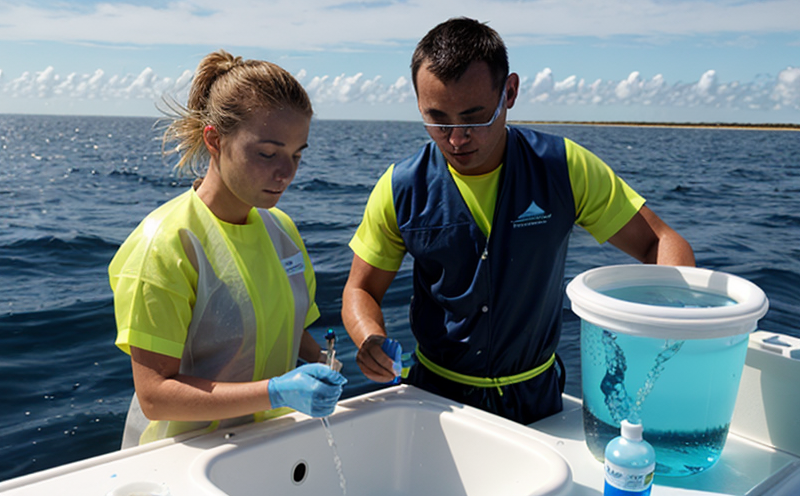ISO 9377-2 Mineral Oil Hydrocarbons Test in Seawater
The ISO 9377-2 standard is an essential tool for quantifying mineral oil hydrocarbon (MOH) contamination in seawater. This test plays a pivotal role in ensuring the quality and safety of water sources, particularly those used in marine environments or processes where the risk of MOH contamination must be minimized.
The importance of this test cannot be overstated given its application across various sectors including maritime industries, environmental monitoring, and wastewater treatment facilities. The presence of MOHs can lead to significant ecological damage and health risks if not adequately controlled. Therefore, compliance with ISO 9377-2 is crucial for maintaining both the integrity of natural water bodies and industrial processes.
The methodology involves several key steps: sample collection, preparation, and analysis using specific chromatographic techniques designed to detect even trace amounts of MOHs. This stringent approach ensures accurate quantification which helps in identifying sources of contamination and implementing effective mitigation strategies.
Compliance with ISO 9377-2 is not only beneficial for regulatory adherence but also enhances brand reputation by demonstrating a commitment to sustainable practices. For quality managers, compliance officers, R&D engineers, and procurement professionals involved in these sectors, understanding this test's nuances is imperative.
Incorporating advanced analytical techniques into routine testing protocols can provide valuable insights into potential pollution sources and aid in developing preventive measures. Regular monitoring using ISO 9377-2 ensures that any increases in MOH concentrations are promptly addressed before they escalate into larger issues.
The global demand for reliable seawater quality assessment continues to grow, driven by increasing awareness about environmental conservation efforts worldwide. By adhering to international standards like ISO 9377-2, laboratories can contribute significantly towards safeguarding our oceans and coastal ecosystems from harmful contaminants.
Applied Standards
The application of the ISO 9377-2 standard in seawater testing is comprehensive and covers various aspects related to mineral oil hydrocarbon contamination. This includes but is not limited to:
- Detection limits for different types of MOHs.
- Sampling procedures tailored specifically for marine environments.
- Preliminary screening methods to identify potential contamination hotspots.
The standard emphasizes the importance of accurate sampling techniques since even minor errors can lead to misleading results. It also provides guidelines on how to handle samples properly before analysis, ensuring that they remain uncontaminated during transit or storage.
For those involved in wastewater management or marine research, familiarizing oneself with these specifications is crucial for conducting reliable tests under challenging conditions often encountered at sea.
Scope and Methodology
The scope of the ISO 9377-2 standard encompasses quantitative determination of total MOH content in seawater samples. It specifies detailed procedures for sample preparation, extraction methods, instrumental techniques, calibration requirements, calculation steps, and reporting formats.
To begin with, appropriate sampling is critical; this involves selecting representative locations along coastlines where there might be higher risks of contamination due to anthropogenic activities such as shipping lanes or industrial discharge points. Samples must then undergo thorough cleaning processes eliminating any external pollutants that could interfere with subsequent analyses.
Following extraction, the resulting solutions are analyzed using gas chromatography coupled with mass spectrometry (GC-MS), a technique renowned for its sensitivity and specificity in identifying complex mixtures of compounds including those present at very low concentrations. Calibration curves ensure accurate quantification by comparing known standard concentrations against measured ones.
Calculated values represent the total amount of MOHs present per liter of seawater. These results provide valuable information regarding current levels of contamination, helping stakeholders make informed decisions about necessary actions to address identified problems effectively.
International Acceptance and Recognition
- The ISO 9377-2 standard is widely recognized by regulatory bodies around the world due to its rigorous testing protocols and consistent results across different laboratories.
- Governments, private companies, non-profits, and international organizations frequently adopt this standard when assessing seawater quality in coastal areas or offshore operations.
Its broad acceptance stems from the fact that it offers a standardized approach which transcends national boundaries. This consistency ensures comparability of data across jurisdictions making collaboration more efficient among various stakeholders involved in monitoring marine environments.
Furthermore, compliance with this international standard enhances credibility and trustworthiness amongst clients seeking assurance about the quality standards met by tested seawater samples. For businesses operating within sectors like shipping, oil exploration, or aquaculture, demonstrating adherence to ISO 9377-2 can be a competitive advantage.





